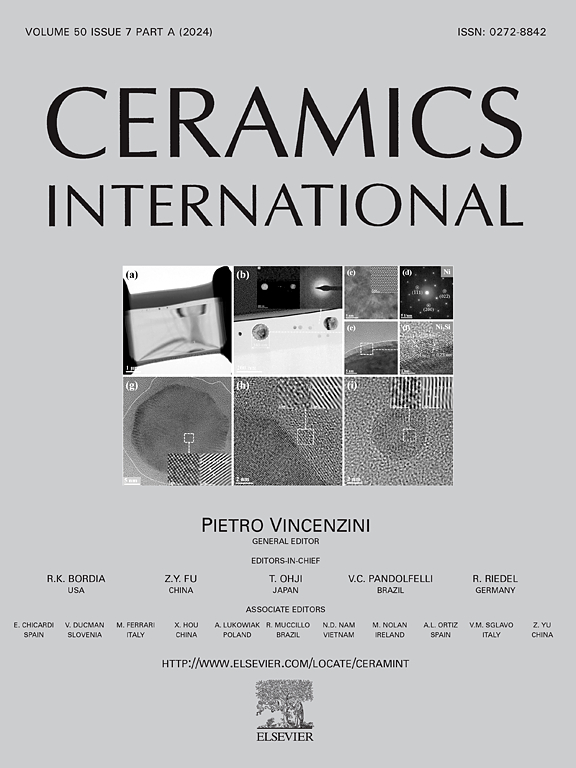Crystal structure, Raman spectra and microwave dielectric properties of a novel low-fired garnet-type ceramic NaCa2Zn2V3O12
IF 5.1
2区 材料科学
Q1 MATERIALS SCIENCE, CERAMICS
引用次数: 0
Abstract
A single-phase garnet-type microwave dielectric ceramic, NaCa2Zn2V3O12, has been successfully prepared via conventional high-temperature synthesis method and its microwave dielectric properties are reported. The NaCa2Zn2V3O12 ceramic was confirmed to belong to the Ia-3d cubic phase and could be sintered to density ceramics with the highest relative density (>95 %) at relatively low temperatures (830–870 °C). Excellent microwave dielectric properties were achieved in the NaCa2Zn2V3O12 ceramics sintered at 850 °C with εr = 11.53 ± 0.2, Q × f = 69,620 ± 2000 GHz, τf = −40.3 ± 0.5 ppm/°C. In addition, the excellent chemical compatibility between NaCa2Zn2V3O12 ceramics and silver electrodes provides a potential candidate material for low-temperature co-fired ceramic (LTCC) substrate ceramics.
新型低烧石榴石型陶瓷NaCa2Zn2V3O12的晶体结构、拉曼光谱和微波介电性能
采用常规高温合成方法成功制备了单相石榴石型微波介电陶瓷NaCa2Zn2V3O12,并报道了其微波介电性能。NaCa2Zn2V3O12陶瓷属于Ia-3d立方相,在相对较低的温度(830 ~ 870℃)下可烧结成相对密度最高(95%)的致密陶瓷。在850℃下烧结的NaCa2Zn2V3O12陶瓷,εr = 11.53±0.2,Q × f = 69,620±2000 GHz, τf = - 40.3±0.5 ppm/°C,具有优异的微波介电性能。此外,NaCa2Zn2V3O12陶瓷与银电极之间良好的化学相容性为低温共烧陶瓷(LTCC)衬底陶瓷提供了潜在的候选材料。
本文章由计算机程序翻译,如有差异,请以英文原文为准。
求助全文
约1分钟内获得全文
求助全文
来源期刊

Ceramics International
工程技术-材料科学:硅酸盐
CiteScore
9.40
自引率
15.40%
发文量
4558
审稿时长
25 days
期刊介绍:
Ceramics International covers the science of advanced ceramic materials. The journal encourages contributions that demonstrate how an understanding of the basic chemical and physical phenomena may direct materials design and stimulate ideas for new or improved processing techniques, in order to obtain materials with desired structural features and properties.
Ceramics International covers oxide and non-oxide ceramics, functional glasses, glass ceramics, amorphous inorganic non-metallic materials (and their combinations with metal and organic materials), in the form of particulates, dense or porous bodies, thin/thick films and laminated, graded and composite structures. Process related topics such as ceramic-ceramic joints or joining ceramics with dissimilar materials, as well as surface finishing and conditioning are also covered. Besides traditional processing techniques, manufacturing routes of interest include innovative procedures benefiting from externally applied stresses, electromagnetic fields and energetic beams, as well as top-down and self-assembly nanotechnology approaches. In addition, the journal welcomes submissions on bio-inspired and bio-enabled materials designs, experimentally validated multi scale modelling and simulation for materials design, and the use of the most advanced chemical and physical characterization techniques of structure, properties and behaviour.
Technologically relevant low-dimensional systems are a particular focus of Ceramics International. These include 0, 1 and 2-D nanomaterials (also covering CNTs, graphene and related materials, and diamond-like carbons), their nanocomposites, as well as nano-hybrids and hierarchical multifunctional nanostructures that might integrate molecular, biological and electronic components.
 求助内容:
求助内容: 应助结果提醒方式:
应助结果提醒方式:


